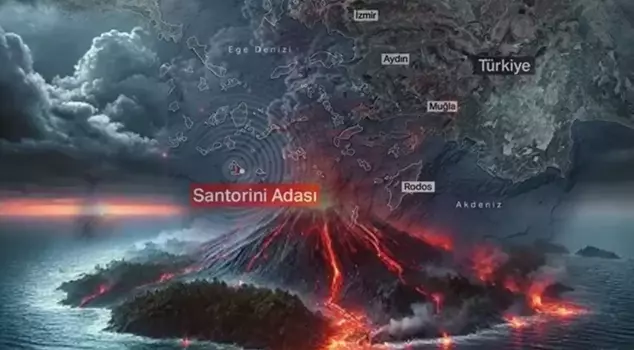
11.02.2025 13:40
The number of earthquakes caused by volcanic activity in the Aegean Sea has exceeded 2,000. It is stated that this activity could lead to a volcanic eruption. Assoc. Prof. Dr. Mehmet Nezih Aytaçlar, who is evaluating the potential eruption of the Santorini Volcano, said, "If there is an eruption similar to the one that occurred in the 1600s BC, the other serious danger would be a climate crisis."
Academics from Ege University evaluated the potential effects of an eruption at Santorini Volcano.
In a statement from the university, Associate Professor Dr. Mehmet Nezih Aytaçlar from the Department of Archaeology at Ege University Faculty of Arts highlighted the impacts of the major eruption that occurred in Santorini in the past.
THREE-QUARTERS OF THE ISLAND WERE DESTROYED IN THE ERUPTION
Aytaçlar noted that the Santorini Volcano erupted 3,650 years ago, stating, "While the island had a round shape, three-quarters of it was destroyed as a result of the eruption, and it took on the C shape we see today. We know there were a series of tsunamis. One of the traces we have identified is the tsunami remnants found at Bağlararası Mound in Çeşme. We suspect that the effects of this tsunami are present along all the coasts south of Urla Beach." he stated.
"ERUPTION WILL AFFECT THE WORLD"
Emphasizing that a major eruption that could occur in Santorini would affect not only Turkey but the entire world, Aytaçlar noted:
"During the ancient eruption that occurred in the 1600s BC, glaciation in the poles was increasing. In fact, the rings of sequoia trees in Canada were narrowing, which means those trees did not receive regular sunlight for several years. A number of sulfurs are released as a result of the eruption, and this sulfur falls to the ground as sulfuric acid with rain, devastating agriculture. If a similar eruption to the one in the 1600s BC occurs, the other serious danger would be a climate crisis. This eruption would lead to significant climate change, posing a threat not only to Turkey but to the world."
"THERE IS MAGMA MOVEMENT"
Dr. Aylin Karadaş, a faculty member in the Department of Physical Geography at Ege University Faculty of Arts, drew attention to the long-term atmospheric effects of major volcanic eruptions.
Karadaş stated that the ashes released into the atmosphere during a violent eruption can remain suspended for many years, saying, "It prevents sunlight from reaching the earth, leading to a drop in temperatures. We know that Santorini experienced a similar eruption in the past. In our drilling studies along the Aegean coasts, we found ashes from Santorini's ancient eruptions among alluvial sediments." she stated.
Karadaş noted that there are some volcanic activities in Santorini, but no magma movement close to the surface has been observed yet, stating, "Magma is active about 5 kilometers deep. For a violent volcanic eruption to occur, the magma needs to rise to the surface." she said.